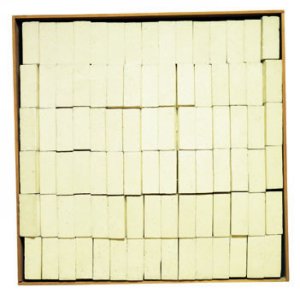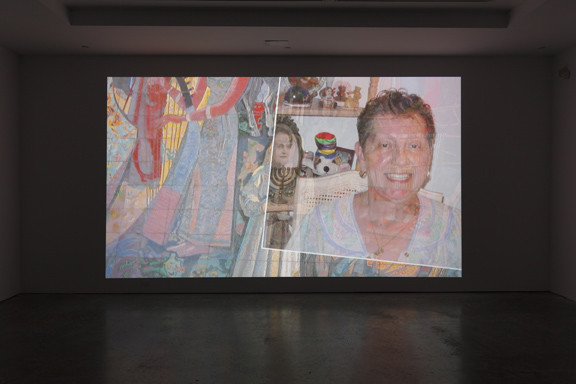Gianni Colombo, February 28th – March 30th
Greene Naftali Gallery, 526 West 26th Street
What’s on view: surprising kinetic sculpture
Paddy Johnson: One of the advantages of commercial exhibitions, is that you’re never forced to read about a career arc that begins with an artist’s great promise, but under developed work, and culminates with their huge successes. Since every work is for sale, the gallery will tell you it’s all great. That has its own kind of mythology, but in this case, I appreciate it a little more, because I really didn’t want to be told that Gianni Colombo’s earlier work was any less significant than his earlier work. I loved almost all the art in this show.
Probably the most striking aspect of the exhibition is the variation within Colombo’s practice. The main gallery is filled with a series of sloping and tiled staircases (intended to produce large scale participatory spaces the artist dubs Ambienti), square kinetic mobiles (impossible to document because they blend in with grids on the windows), and walls filled with minimalist works reliant on line and tension. I was particularly enamored with wall works like the white wheel that had white thread spun from the center. It’s a simple gesture, but your eye never stops moving around the surface. The piece just gets better the longer you look at it. The same can be said for the piece beside it; a gridded surface disrupted by organically arranged wire. The fissures in order are so satisfying to look at. There are seemingly countless success pieces like this in the show, so that made me enormously happy.
In the back room there were a number of glazed ceramic pieces made earlier in his career. These are a great addition to the show if for no other reason than visual contrast—they are a very different approach to art making than anything in the front room—and almost all of them look contemporary. Three are stands stacking plates of various shapes; a piece with three yellow mushroom-like plates, and another with six fat roundish blue plates were most interesting to me, but that might be because the color palette of the third was less appealing to me—a greyish-brown—and there were too many plates on the stand to really appreciate them.
Whitney Kimball: I think it’s safe to say that this was Paddy’s favorite show. You’re not allowed to touch the works in the gallery, which is a huge problem, because it’s a lot of fun– especially the wall-mounted styrofoam boxes. You twist some little knobs at the bottom of the box to create a very slight rippling effect in the styrofoam blocks; while you’d expect kinetic works to twist and spin, Colombo just invites you to tickle them a little bit. It’s a really pleasant surprise, and it makes these feel like skin. I don’t know what else it does, beyond just being intimate, but I like the thinking. There’s also a large-scale machine-operated one in the corner, which sounds like a steamroller in quiet gallery, but the movement is likewise very gentle.
Corinna Kirsch: Yup, I agree with all of the above. It’s probably worth noting that walking into the gallery, the first works I saw weren’t necessarily interactive ones: they were more like chance-based works, with strings attached to nails.
Will Ryman, America, February 28th – March 30th
Paul Kasmin Gallery, 515 West 27th Street
What’s on view: A log cabin, spray painted gold, encrusted on the inside walls with keyboards, shotgun shells, arrowheads (I think), tent stakes, phone lines, lightbulbs. Additional black paintings in the back with similar surfaces.
Corinna: Well, here’s a lot of attention-grabbing, shiny stuff that wouldn’t be out of place at an art fair. In Will Ryman’s “America”, you can enter a gold, spray-painted cabin (called “America”), and boy, it smells like it was painted the day of the show. There’s an attention to detail here—with the car parts, shackles, grenades, and indecipherable bric-a-brac—that’d be appreciated in any other context that wasn’t so heavy-handed. In general, yes, I do love to let my eyes roam across minutiae that’s squashed and glopped together; when that bricolage is done well, variation comes to the fore. That doesn’t happen here because all the little “things” point to just one big thing: wayward Americana.
Whitney: I actually thought this was a more nuanced side of what I’ve seen from Will Ryman, which says a lot about flower sculptures and giant birds. And yeah, it was at least stimulating to separate out the shapes from the gold, but again, no surprises once you figured out what those were.
Corinna: Eek. It’s scary to think this is Ryman-in-restraint. But looking over the rest of his “oeuvre”, you’re totally right.
Brandon Lattu, Not Human, February 28th – April 6th
Leo Koenig, 545 West 23rd Street
What’s on view: A slideshow of photos layered by overlapping the central face in each image (so that the backgrounds change, but the eyes stay in the same point); another video slideshow juxtaposing visually similar images (via image search); and monochromatic wall-mounted rhombus sculptures with photo environments printed on the sides.
Corinna: This exhibition brings up one of my minor pet peeves: Internet-related art that merely illustrates how the Internet works. In Lattu’s case, he’s showing how Googling works, which isn’t really novel. “Lattu brings to light the problem that one search term will bring back a myriad of results” is, by now, a way of life. I’ve had enough with Internet 101-type art.
Still, Lattu’s videos do have an almost melodic pacing to it, making it pleasing to zone out to inside Koenig’s dark viewing room, watching one image melt into another.
Paddy: I think your summation of the work is a little dismissive. To begin with, Lattu is working with an archive of over 120,000 images culled from the internet or scanned, and to amass that kind of volume takes a certain amount dedication. In so far as I can tell, the work doesn’t have as much to do with Google, as it does what constitutes similarity. On one screen, images are arranged so that one image has absolutely nothing to do with the next. We see a happy face, then a face on a photo, framed, then a panda and a yellow dog with the use of picture frame repeated. Even though the artist had gone out of his way to make sure the images had nothing to do with each other, I found myself instinctively seeking connections. And of course, there were some. There always are.
On the other screen, Lattu runs his images through Google for similar objects and presents the results. I wrote down the sequence of images I saw while I was there: Bones, rocks, snake, rocks, flowers, rocks. Video tape, red rainbow, wine, red purse. They were easier to group for sure, and the slide show felt a little like toggling through images on the net.
Based on my experience with the first screen, I suspect that comparison to surfing is less substantive than I might have might normally conclude; it’s probably a similarity I saw because I was looking for one. I don’t know how deep that message is, but I can enjoy it for what it is.
Corinna: OK, I am probably being unfair to Lattu, but I’m still not convinced that his logic of grouping by similarity is that great. Honestly, I’m conflicted: I’m interested in Lattu’s obsessive collecting and how we deal with all the images we hoard on our hard drives, but I’m just not sure what’s the best way for Lattu—or anyone else—to succeed at showing that compulsion in the gallery. The answer’s probably not a slideshow.





Comments on this entry are closed.